-
Recent Posts
Archives
- October 2022
- August 2022
- May 2022
- March 2022
- January 2022
- December 2021
- September 2021
- July 2021
- June 2021
- May 2021
- April 2021
- February 2021
- January 2021
- November 2020
- October 2020
- September 2020
- June 2020
- April 2020
- March 2020
- February 2020
- January 2020
- December 2019
- November 2019
- October 2019
- September 2019
- June 2019
- March 2019
- February 2019
- January 2019
- December 2018
- November 2018
- October 2018
- August 2018
- July 2018
- June 2018
- May 2018
- April 2018
- March 2018
- February 2018
- January 2018
- December 2017
- November 2017
- October 2017
- September 2017
- August 2017
- July 2017
- June 2017
- May 2017
- April 2017
- March 2017
- February 2017
- January 2017
- December 2016
- November 2016
- August 2016
- July 2016
- June 2016
- May 2016
- April 2016
- March 2016
- February 2016
- January 2016
- December 2015
- November 2015
- October 2015
- September 2015
- August 2015
- July 2015
- June 2015
- May 2015
- April 2015
- March 2015
- December 2014
- June 2014
- May 2014
- April 2014
- November 2013
- September 2013
- August 2013
- July 2013
- June 2013
- May 2013
- March 2013
- January 2013
- November 2012
- October 2012
- July 2012
- December 2011
- November 2011
- October 2011
- September 2011
- August 2011
- July 2011
- June 2011
- May 2011
- April 2011
- March 2011
- February 2011
- January 2011
- December 2010
- November 2010
Categories
Surgery Success Opie
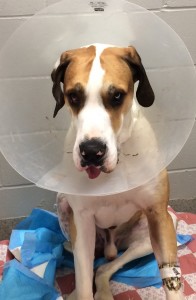 Opie is a two-year-old Great Dane recently referred to NorthStar VETS. Opie had been favoring his right rear limb for a few months and then became acutely more lame after playing outside with his housemate. Initial radiographs and exam suggested rupture of his ACL. However, when another X-ray of the knee was taken we became suspicious of a condition known as Osteochondritis Dessicans (OCD). This condition typically occurs in young growing dogs and is due to abnormally developing cartilage and bone. As a result a weak spot forms in the joint causing pain and lameness.
Opie is a two-year-old Great Dane recently referred to NorthStar VETS. Opie had been favoring his right rear limb for a few months and then became acutely more lame after playing outside with his housemate. Initial radiographs and exam suggested rupture of his ACL. However, when another X-ray of the knee was taken we became suspicious of a condition known as Osteochondritis Dessicans (OCD). This condition typically occurs in young growing dogs and is due to abnormally developing cartilage and bone. As a result a weak spot forms in the joint causing pain and lameness.
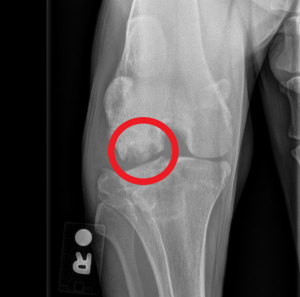 Dr. Daniel Stobie and Dr. Kelly Johnson of the NorthStar VETS Surgery team performed an OATS procedure (Osteochondral Autograft Transfer System) on Opie’s right stifle. This is a procedure where a plug of normal cartilage and bone is collected from another site in the joint. The plug is then placed in the site of weakened cartilage to help restore and heal the joint surface. The procedure went well and Opie will be seeing our Rehabilitation Department to help him heal and strengthen his new joint!
Dr. Daniel Stobie and Dr. Kelly Johnson of the NorthStar VETS Surgery team performed an OATS procedure (Osteochondral Autograft Transfer System) on Opie’s right stifle. This is a procedure where a plug of normal cartilage and bone is collected from another site in the joint. The plug is then placed in the site of weakened cartilage to help restore and heal the joint surface. The procedure went well and Opie will be seeing our Rehabilitation Department to help him heal and strengthen his new joint!
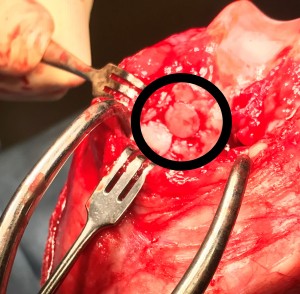
Figure 1: The circular piece of bone in the center of the image was removed from a nearby piece of bone and inserted into the defect in the knee.
Learn more about the Surgery service at NorthStar VETS.
Daniel Stobie, DVM, MS, DACVS – Chief of Staff
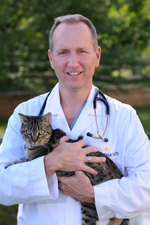 A New Jersey native, Dr. Stobie completed his undergraduate work at Cook College/Rutgers University and is a 1990 cum laude graduate of the University of Missouri-College of Veterinary Medicine. He completed an internship in small-animal medicine and surgery at the Angell Memorial Animal Hospital in Boston, then went on to complete a three-year surgical residency at the University of Minnesota and earn a Master’s Degree in Veterinary Surgery, Radiology, and Anesthesia in 1994. Dr. Stobie became a Diplomate of the American College of Veterinary Surgeons in 1995. In 2007, he completed the mini-MBA certificate program at the Rutgers School of Business. Learn more about Dr. Daniel Stobie.
A New Jersey native, Dr. Stobie completed his undergraduate work at Cook College/Rutgers University and is a 1990 cum laude graduate of the University of Missouri-College of Veterinary Medicine. He completed an internship in small-animal medicine and surgery at the Angell Memorial Animal Hospital in Boston, then went on to complete a three-year surgical residency at the University of Minnesota and earn a Master’s Degree in Veterinary Surgery, Radiology, and Anesthesia in 1994. Dr. Stobie became a Diplomate of the American College of Veterinary Surgeons in 1995. In 2007, he completed the mini-MBA certificate program at the Rutgers School of Business. Learn more about Dr. Daniel Stobie.
Kelly Johnson, DVM, MS, DACVS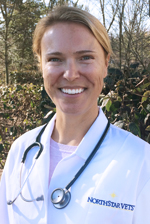 Dr. Kelly Johnson is a Vermont native who received her undergraduate degree from the University of Richmond in 2002. She earned her veterinary degree from Michigan State University in 2006. After graduation she completed a small animal rotating internship at the Hope Advanced Veterinary Center in Vienna, VA followed by her surgical residency at the Virginia-Maryland College of Veterinary Medicine. During her residency she also completed a Master’s Degree in Biomedical and Veterinary Sciences. Dr. Johnson practiced as a small animal surgeon in northern NJ for nine years before joining NorthStar VETS in 2020.
Dr. Kelly Johnson is a Vermont native who received her undergraduate degree from the University of Richmond in 2002. She earned her veterinary degree from Michigan State University in 2006. After graduation she completed a small animal rotating internship at the Hope Advanced Veterinary Center in Vienna, VA followed by her surgical residency at the Virginia-Maryland College of Veterinary Medicine. During her residency she also completed a Master’s Degree in Biomedical and Veterinary Sciences. Dr. Johnson practiced as a small animal surgeon in northern NJ for nine years before joining NorthStar VETS in 2020.
Dr. Johnson is trained in the tibial tuberosity advancement (TTA) and lateral extracapsular suture techniques for cranial cruciate ligament disease. Outside of work she enjoys paddle boarding, yoga, downhill skiing, traveling, attending country concerts and watching the New York Rangers.
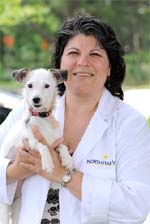 Rosalie LoScrudato, DVM, CVA, CCRP
Rosalie LoScrudato, DVM, CVA, CCRP
Certified Veterinary Acupuncturist, Certified Canine Rehabilitation Practitioner
Dr. LoScrudato received her undergraduate degree from Cook College, Rutgers University, and graduated from the University of Missouri College of Veterinary Medicine in 1990. After graduation, Dr. LoScrudato returned to New Jersey and practiced small animal medicine for 17 years, developing an interest in emergency and critical care medicine. She joined NorthStar VETS in 2007 as an emergency clinician.
Dr. LoScrudato earned her certification in veterinary acupuncture in 2009 from the Chi Institute. Dr LoScrudato started the Acupuncture service at NSV in 2009, giving our hospital another avenue to improve our patients’ comfort and function. Beginning in 2011, she transitioned from our ER department and dedicated her time to building the rehabilitation and pain management service at NSV along with Dr Pamela Levin. She completed her certification as a canine rehabilitation practitioner from the University of Tennessee College of Veterinary Medicine in 2012. Dr LoScrudato was certified in companion animal pain management in March 2015. She considers her greatest achievements her four beautiful children. Dr LoScrudato enjoys music, spending quality time with her children, and fishing.
This entry was posted in Pets, Veterinary Medicine and tagged Daniel Stobie, Kelly Johnson DVM, NorthStar VETS, OATS procedure, Opie, Osteochondral Autograft Transfer System, Osteochondritis Dessicans, veterinary surgery. Bookmark the permalink.





Leave a Reply